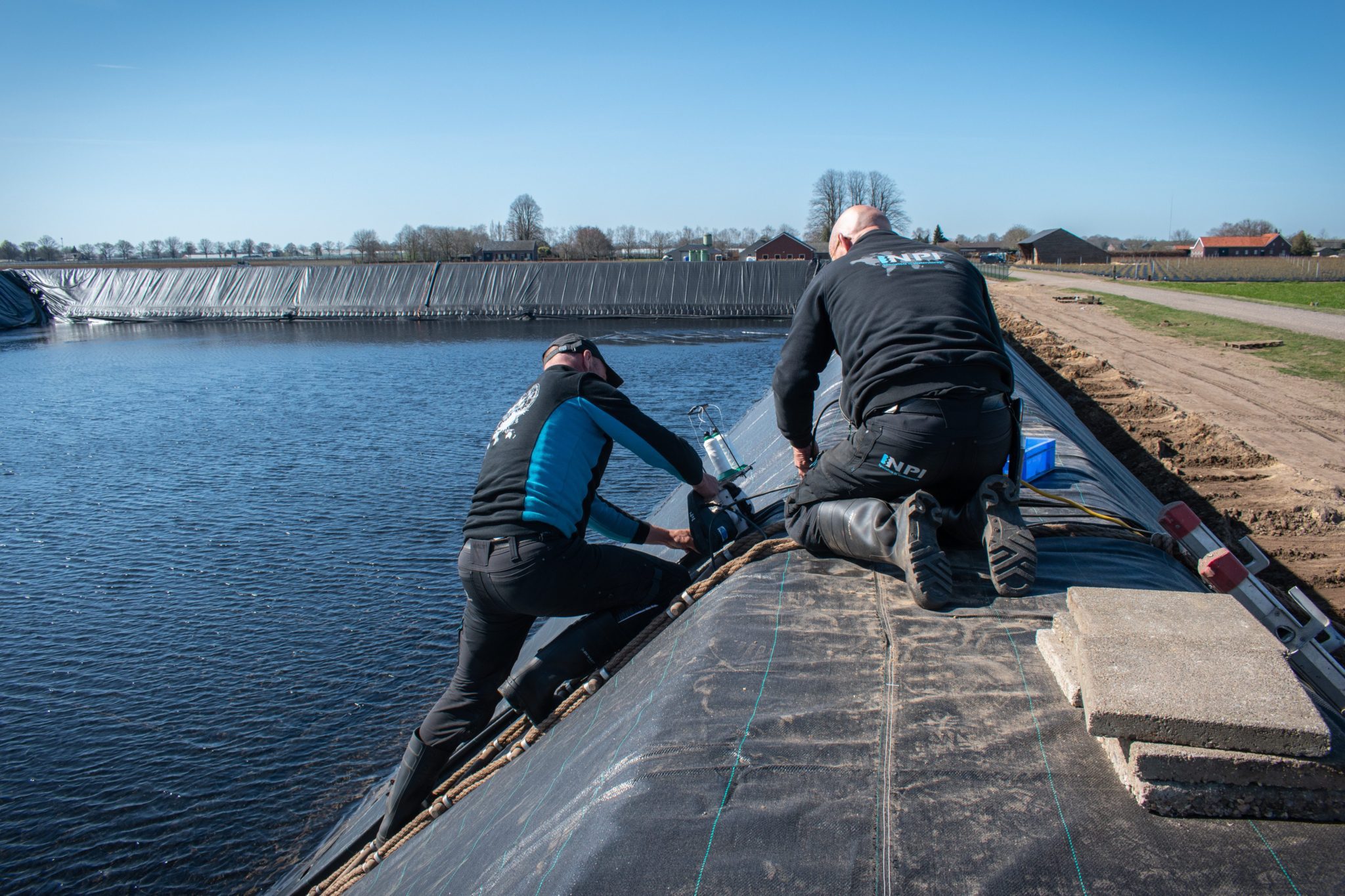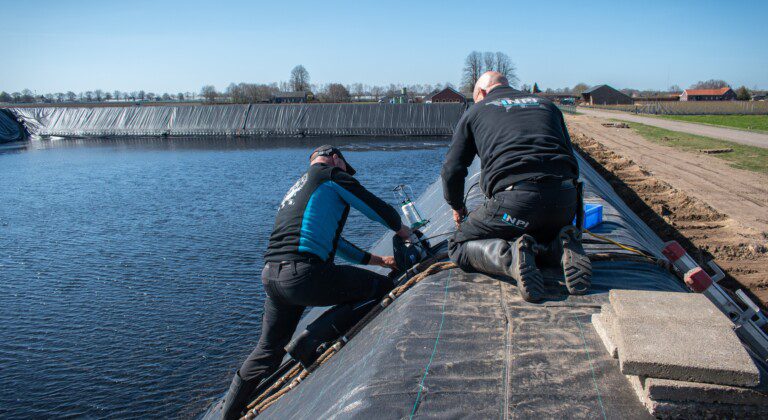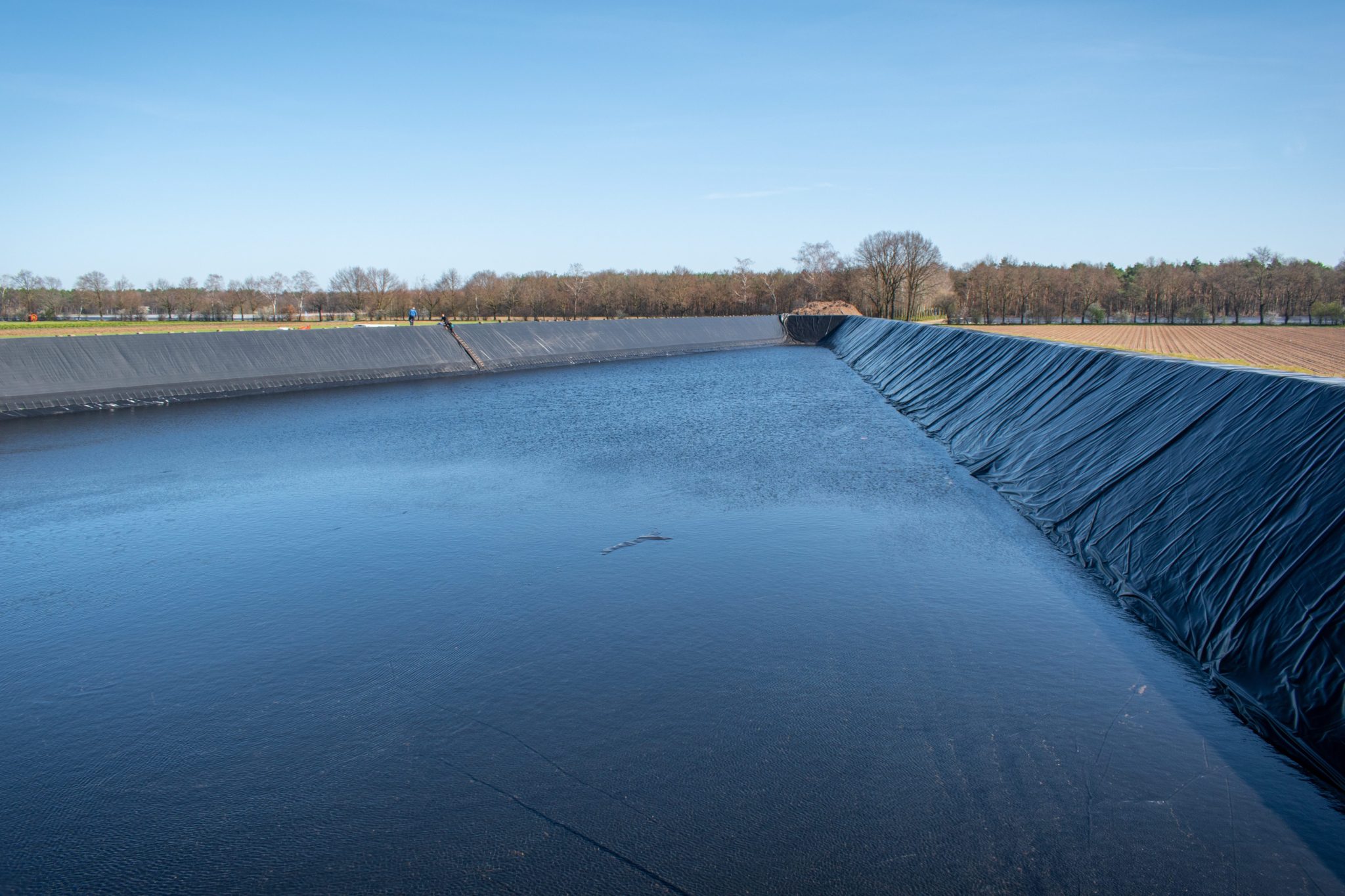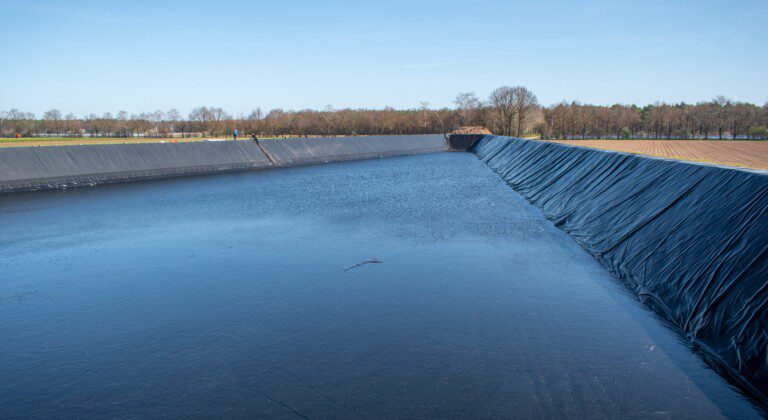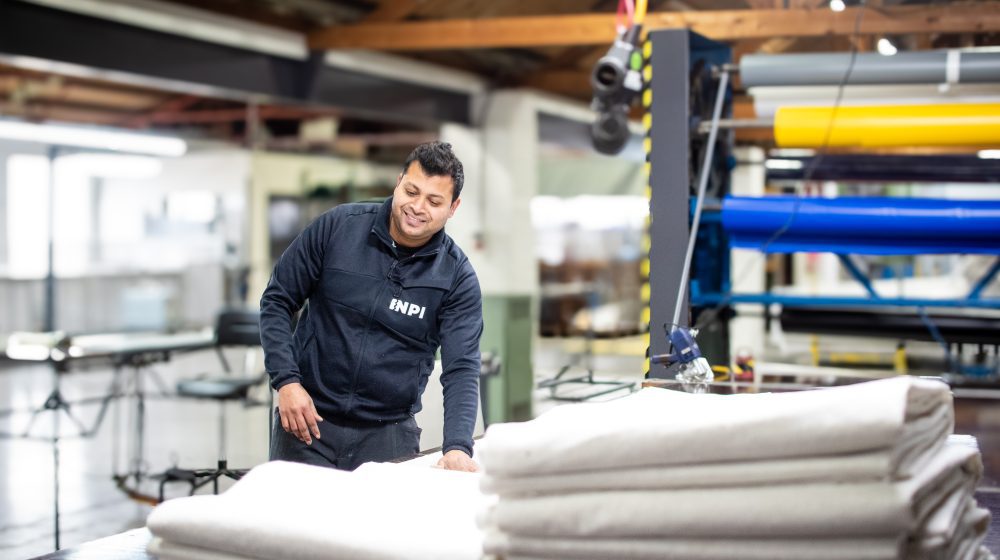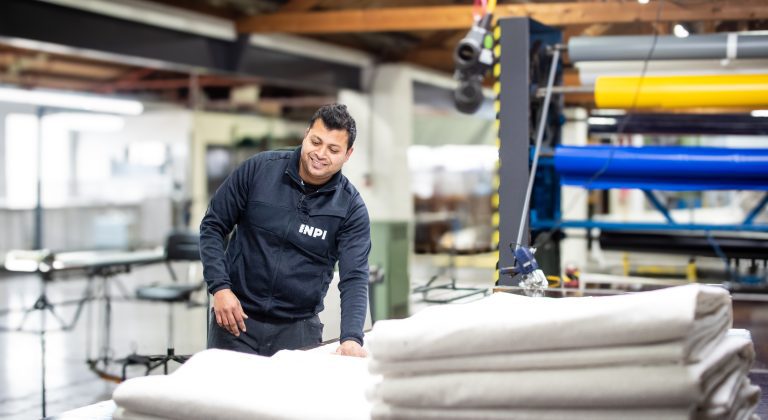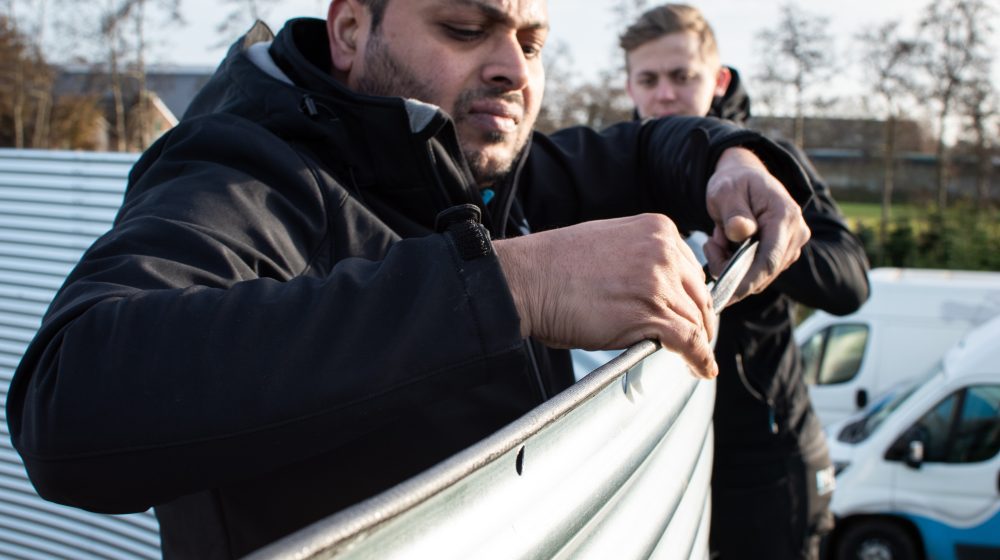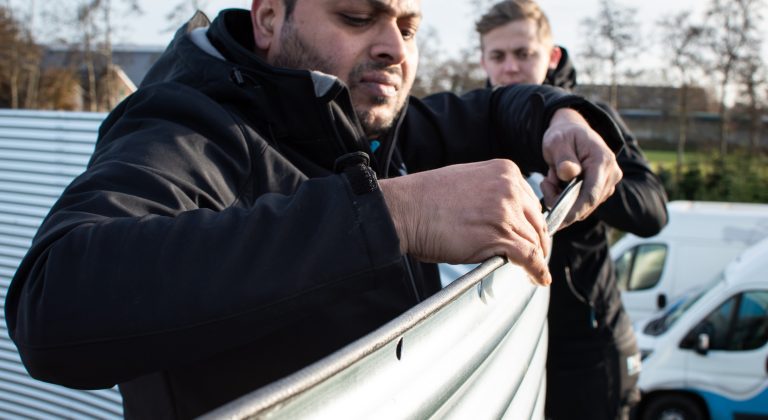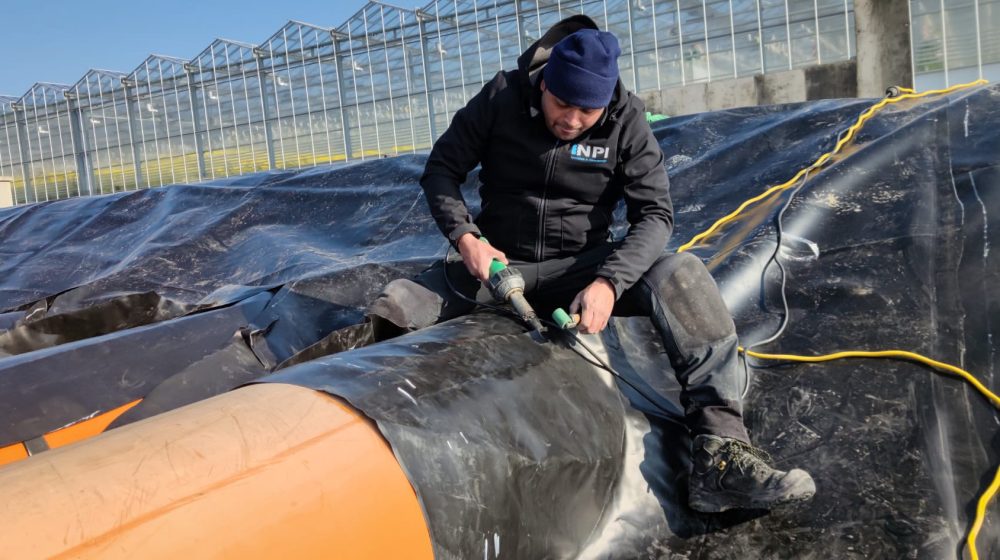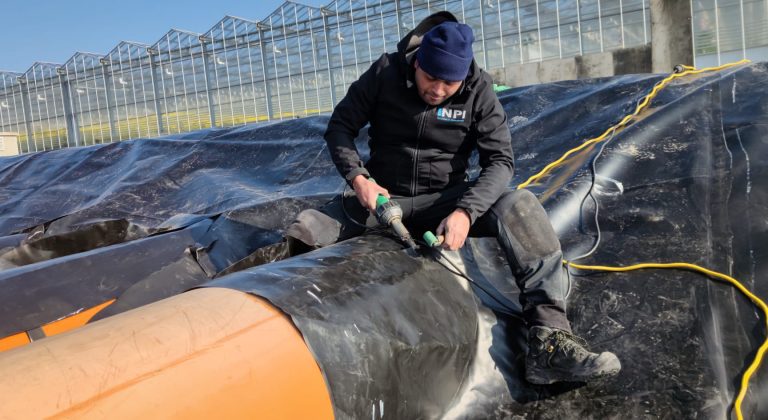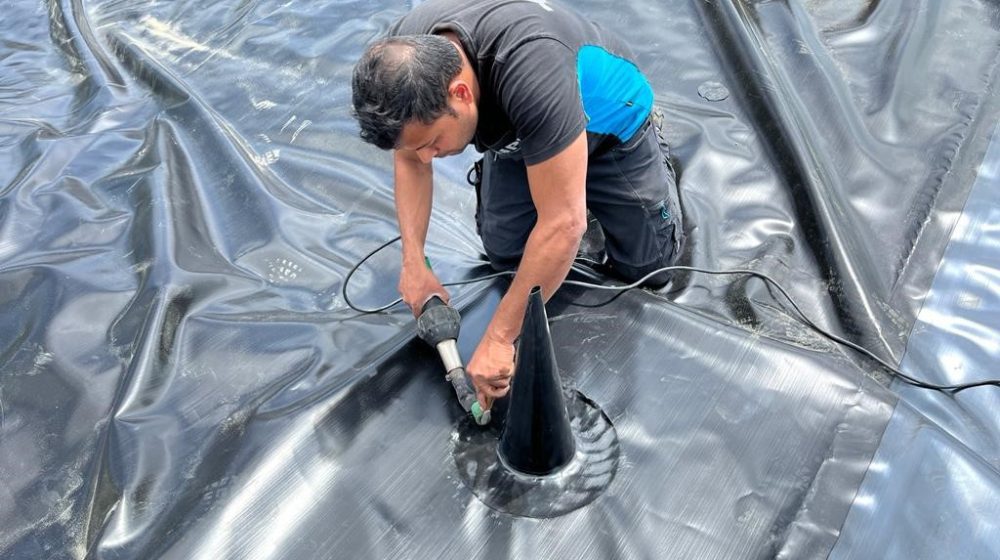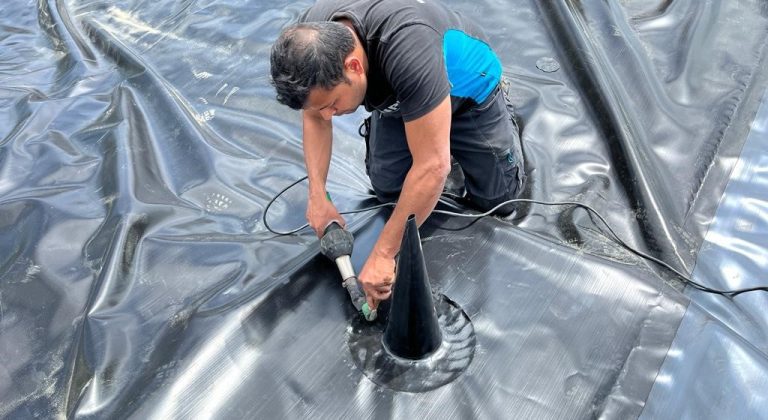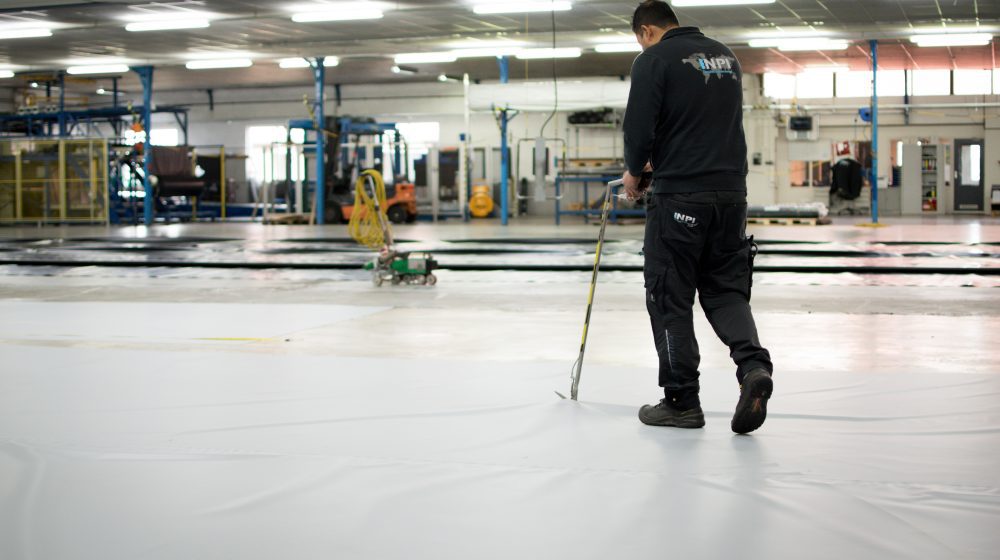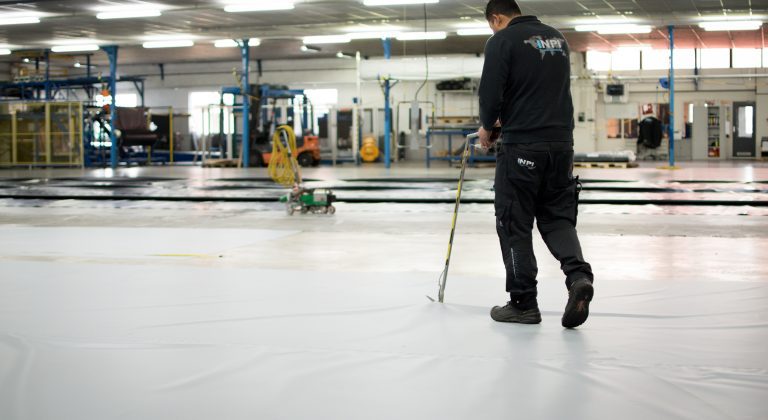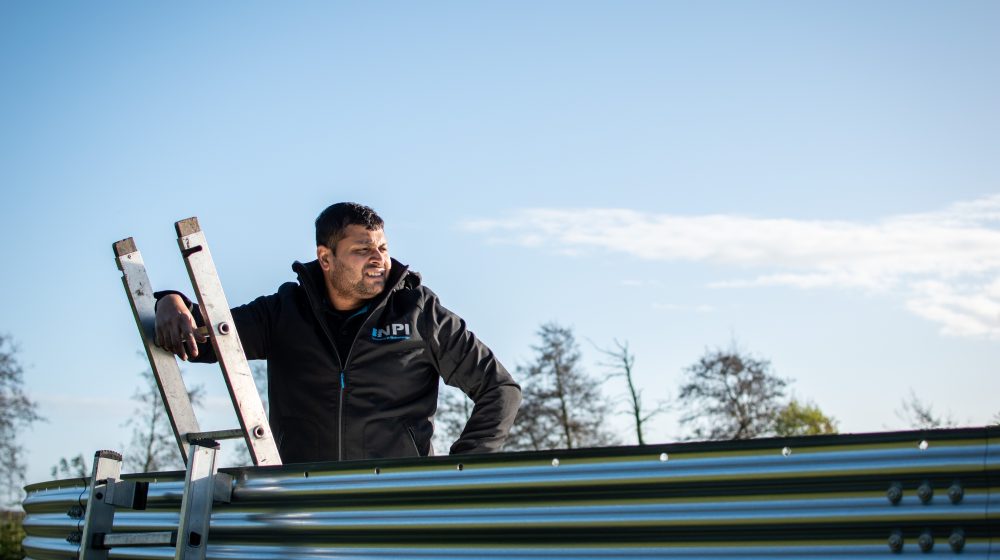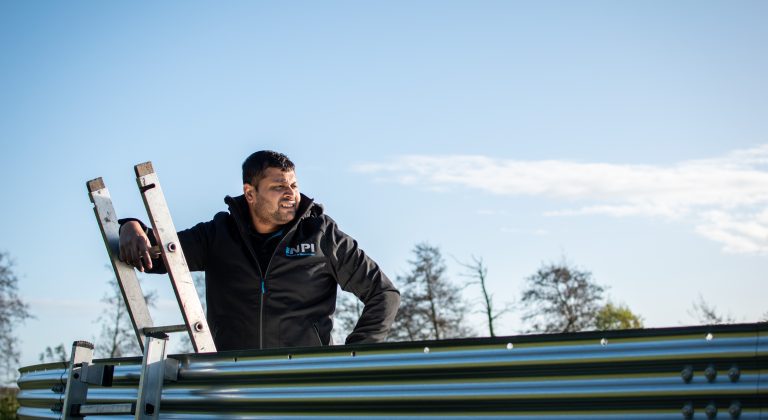The value of water storage in fruit growing
Water is not always available when the trees need it
Fruit growers also suffer from climate changes, dealing with both extended periods of drought and moments of waterlogging. Some days bring as much precipitation as normally falls in a month, while other months see no drop of rain.
For fruit growing, both soft and top fruit, sufficient and good-quality water is one of the primary conditions for healthy harvests. Drought is by far the biggest stress factor threatening production. It directly impacts the growth of plants and trees, and thus affects yields in both volume and fruit size.
We can no longer take the availability of water for granted. For some growers dependence on rainwater is high, as groundwater is too deep, piped freshwater can be costly, and some areas also suffer severely from salinisation. Therefore, more and more fruit growers decide to capture rainwater or any other type of water they can access. They store it and use it later when needed through drip irrigation.

Water whenever you need it
Water that becomes available through rain, a well, or surface water is often not directly usable at the moment it is needed. A buffer tank temporarily stores the water, allows for filtering or mixing recipes, and enables it to be used at the exact moment when the trees need it. Especially in modern irrigation systems timing is crucial: too much or too little water at the wrong moment can have immediate consequences for yield and quality.
Water storage tanks offer peace of mind. They make irrigation systems less dependent on weather conditions or the immediate availability of water. This gives growers greater flexibility in their planning and the confidence that they can always provide their trees with what they need.
Practical examples: from soft fruit to apple orchards
NPI water tanks support the irrigation of countless apples, pears and soft fruit crops around the world, from large companies with high-tech irrigation systems to small-scale growers. Below is a selection of our projects with fruit growers:
With increasing pressure on water resources and changing climate conditions, the importance of water storage continues to grow. By storing rainwater or other available sources in tanks, fruit growers can work more efficiently and better handle dry periods and peak demand. Water buffering is not just a practical solution; it is an investment in future-proof cultivation. That is where our water tanks make a difference every day.
A sustainable way to meet rising demand for fish
Overfishing and its impact
Overfishing is one of the biggest threats to marine biodiversity today. It puts entire ecosystems under pressure and leads to the rapid decline of fish populations. As global demand for fish continues to grow, we need alternative and sustainable ways to meet it.
(Small scale) fish farming as sustainable alternative
Farming fish, when practiced responsibly, can be a good and sustainable source of nutrition, while taking off pressure off wild fish populations. It is more and more practiced worldwide, and not only in large scale operations. In countries in Africa, Asia and the Caribbean, more attention is being given to small-scale aquaculture and even backyard setups, promoted by the FAO as a way to improve food security. Small-scale farms can work responsibly, since they use few resources, produce little waste and are often managed by local families or communities. Both food and income stay local.
Despite small operation sizes, a professional set-up pays off: water can be recycled, it reduces waste and ensures fish grow in a clean, controlled environment.
Water management and tanks
Water management is at the heart of every professional fish farm set up. Farmers need water storage systems that give them control; over water quality, temperature, flow patterns and hygiene. Efficient water use is also essential. Even the smallest operations more and more often include metal water tanks as cultivation ponds. Why? The corrugated steel of the tanks allows for minimal maintenance and long-term use. Besides, their modular design makes the tanks extremely easy to transport, install or relocate, even at difficult to access places. The greatest advantage of metal water tanks for fish farming, is that the tanks can be produced in every desired height or diameter, tailored to the type of fish being farmed and size of operation.

The advantages of fish farming in metal water tanks
- High control over water quality and circulation
- Climate-resilient and built for outdoor use
- Low maintenance, long lifetime
- Easy to transport, install or relocate
- Supports a closed system: less water and nutrient loss
- Efficient for feeding, harvesting and daily tasks
- Safe for both fish and farmer
- High water capacity on a small area
Minimising environmental impact and SDGs
Our water tanks support the recycling of water and help minimising environmental impact. And the tanks not only help to conserve resources but also improve fish quality. In the face of climate change, installing metal water tanks will help in advancing key Sustainable Development Goals (SDGs). It will support water security (SDG 6) and contributes to achieving Zero Hunger (SDG 2) by providing access to healthy and sustainable proteins. It also helps to protect Life Below Water (SDG 14) as it relieves pressure at wild fish stocks.
We support the shift toward more responsible food systems. Our tanks are part of that, helping (small scale) farmers to produce fish in a controlled and sustainable way. Aquaculture holds the key to meeting the growing demand sustainably.
Curious how our tanks support fish farmers around the world? Explore our aquaculture projects:
Ensuring optimal water quality preservation
Around 85% of our water tanks are complemented with a cover. A decent water storage system is the foundation in water management, but the importance of an adequate cover should not be overlooked! With a cover in place, water quality is optimally preserved. How does this work?
Contamination prevention
In an uncovered water tank, algae can grow quickly and other contaminants can pollute the water. This often leads to clogged irrigation systems, which can cause various problems. The primary function of a tensioned anti-algae cover is to inhibit the growth of algae, while additionally serving to shield the water from contamination by small debris and reduce water evaporation.
Properties of our anti algae covers
Our tensioned anti-algae covers are made from 210 grams woven polypropylene with a reinforced edge and stainless steel eyelets. This cover is subsequently attached to the outside of the tank with special hooks and nylon cord. The woven design allows water to permeate through the cover, but keeps dirt and light out.

Applications
The tensioned anti-algae covers can be installed at both indoor and outdoor water tanks, in all kind of applications. They are most suitable for tanks with a diameter of up to approx. 9 metres. For larger diameters, we recommend installing a reinforcement ring in the upper ring, combined with a centre pole. A centre pole keeps the cover slightly lifted, so that rain that falls easily slides down in order to avoid sagging. Read our recommendations on how to handle your anti-algae cover in wintertime.
Water quality
Equipping a metal water tank with a tensioned anti algae cover is a smart and effective way to protect the water. Keeping the water clean and safe for longer helps deliver stronger results for your operations.
Advantages
- High UV-resistance
- Maximum reduction in algae growth
- Blocking debris
- Easy to install
- Compact for transport
- Permeable
- Low maintenance
Water basins are the future of sustainable farming; they ensure water security in drier periods
Anyone who could, enjoyed the sunny weather in March, April and May. The downside of this beautiful spring is the growing drought; it was the driest March since records began in 1906. There has been barely any rain in the past three months, and even though some rain is on the way, it will not be enough to end the drought. Dutch news headlines talk about wildfires and threats to nature, horticulture and agriculture as groundwater levels drop.
For (fruit) farmers, the drought means a year full of uncertainty as fields and orchards dry out from the sun and wind. It causes stress to plants and stress for farmers. Now that the fruits and crops start to grow, water is running low, leading to a risk of lower yields and higher costs. In some areas, salty water also increases the risk of damage to fruits and vegetables.
Not all farmers and gardeners are nervous, though. They have a weapon in this battle: an excavated water basin.
Water basins
A water basin is an artificially created water reservoir, partially dug into the ground. The excavated soil is used to create embankments. NPI lines the basin with high-quality film, making it fully waterproof and helping maintain the water level.

Application
There is growing attention on water buffering, and rightly so. A water basin can be used to store water during wet periods and use it during dry periods. Water that is collected by the basin itself, or water from rooftops or paved surfaces can be stored in the basin. Over the past 65 years, NPI has lined hundreds of basins, many of them for drought protection. The water is used for irrigation in horticulture, fruit cultivation, agriculture, public green spaces, recreation or other purposes.
Water basin as a weapon in the fight against drought
For small businesses, using tap water can be an option, but for larger companies the capacity is often insufficient. During droughts, there is typically a peak in demand for tap water in general, and extra demand from horticulture and agriculture is not desired. In some areas, restrictions or bans on using surface water for irrigation are in place, limiting farmers’ options even further. Water basins are ideal for farmers who need to store large volumes of water. They reduce pressure on the local drinking water supply, keep businesses running and make farmers less dependent on the availability and quality of incoming water, offering them peace of mind during dry periods.

Basin liner
NPI lines basins with a film that best suits the local conditions. In many cases, this is our high-quality ENPEX FPP. Besides excellent resistance to UV and weathering, ENPEX FPP combines great mechanical properties with a wide range of chemical resistance. It is chemically inert, very flexible and has excellent dimensional stability across a wide temperature range. We produce basin linings up to 5,000 m² in our production facility. For larger basins, the film we supply the film in multiple panels and weld them together on-site. The film is installed over the entire embankment and buried at ground level.
Connections
Waterproof connections are installed on the pipings, made from the same type of film used to line the basin. The inlets and outlets are welded onto the basin film at the correct locations on-site.
Embankment protection
All the water basins we install are protected with heavy-duty geotextile featuring a tile edge. This protects the film above the waterline from weather, animals and weeds. The slope protection is buried at ground level, and tiles are placed in the seam to keep the geotextile in place. We produce the geotextile at our facility so that only the corners need to be sewed on-site.
NPI works closely with partners who handle permits, soil research, excavation of the basins and any necessary maintenance.
The advantages of a basin with film
- A basin can be installed in any shape and size as needed. This offers companies great flexibility, as they can install a basin on any available piece of land on their property. Irrigation specialists calculate the required capacity based on the number of hectares to be irrigated, the amount of water and the irrigation frequency. Any size basin is possible; water basins are especially suited for farmers needing to store large volumes of water, unlike smaller storage systems.
- The liners are fabricated and welded under perfect conditions. Most of the basin liners we can prefabricate in our factory.
- Compared to other types of water storage, an excavated water basin has a low investment cost per square meter.
- Quick installation on-site. The film can be rolled out and shaped easily to fit the basin.
- Because our lining materials are strong and durable, a basin can last for many years with minimal maintenance.
Salinisation
Water basins also serve as a weapon in the fight against salinisation, which occurs in many areas worldwide, especially in dry and coastal regions. In recent years, we have lined several basins in areas where salinisation is a problem and causes water shortages in agriculture. By collecting rainwater in a basin, farmers have a supply of clean, fresh water that they can use for irrigation. This also helps to keep the soil healthier and prevents further salinisation.
Plan ahead and reduce the impact of future drought periods
To effectively deal with drought, thinking ahead is essential. This means we should not just respond to the current situation but also plan proactively and take measures to reduce the impact of future drought periods.
With united effort, 15,000 m2 of ENPEX FPP is pulled into this basin in Zeeland
All the ins and outs about inlets and outlets
In every water storage tank, inlet(s) and outlet(s) are unmissable elements. They regulate the flow of water into and out of the tank. The inlet is where the water goes into the tank from sources like a rainwater harvesting system, canals and boreholes, while the outlet is where the water leaves the water tank to go to other tanks or the point of use.
Placement
Inlets and outlets are typically installed at strategic points to ensure efficient water flow. The inlet is often positioned near the top of the tank, while the drain outlet is usually located at or near the bottom to ensure the tank can be fully emptied when needed. The placement depends on factors such as the tank’s size, shape, intended use and the irrigation system’s requirements.
Types of outlets
Conical outlets
We manufacture conical outlets using customized machinery. Each outlet includes a footplate and a conical sleeve, both of the same material as the silo lining, such as our high-quality FPP. Because of the cone shape, the supplied metal clamp and tape, the outlet fits watertight over the connected pipe. For the most common pipe diameters we supply standard sized outlets, but we can also produce them to specific requirements.
We can also install the outlets “blind”, placing the outlet without creating a hole in the liner. If the tube is eventually not installed at the intended location, the outlet can be removed without damage damaging the liner.
Finally, we also supply the conical outlets separately. Customers can assemble the outlet themselves with a heat gun. We have kits available for self-installation.

Mechanical outlets
When the exact locations of inlets and outlets are not yet determined, a mechanical outlet is the ideal outlet type. These are PVC flanged outlets, consisting of a top and bottom flange, that can be installed on-site using a screw connection.
Mechanical outlets are typically installed at the bottom of the tank and they come in various diameters.
The main advantage of a mechanical outlet is that it allows you to almost completely empty the tank, as the outlet lies flat in the tank bottom.

Galvanised outlets
Galvanised outlets have been specially designed for installation in tank walls to fill and draw water from the tank. They can also be used to empty the tank, but not completely, as the outlet is ideally positioned halfway up the panel, leaving approximately 40 cm of water in the tank.

Overflow
At nurseries and greenhouses, metal water storage tanks often collect rainwater. Growers must prevent these tanks from overflowing, as this can damage the metal and possibly harm the surroundings.
Different systems can help, such as an overflow, a float system or sensors, with or without digital monitoring.
How our water tanks maximise safety for fish and man
Fish farming, also known as pisciculture, is one of the world’s fastest growing food sectors. It is a type of aquaculture, which involves breeding fish, shellfish or algae cultivation primarily for commercial purposes. However, it is also more and more cultivated for private use. While fish farming traditionally occurs in fish ponds or at sea, land-based farms are becoming increasingly popular. NPI steel water tanks have proven to serve perfectly in these land-based fish farms.

The advantages of fish farming in steel water tanks
Steel water tanks offer numerous advantages in fish farming:
- High control over water quality and parameters
- The flow pattern and circulation is better in circular tanks
- Climate resilience
- Modular design: easy to transport, to install, to move and allows for scalability
- Less waste of water and nutrition thanks to the closed system
- Feeding and harvesting operations require less time and labour
- High capacity on small area
- Low maintenance cost
- Long lifetime
- Safety for fish and man!
Safety for fish and man
We conclude this enumeration with safety, which is a very important aspect in fish farming and steel water tanks. Fish farming concerns the cultivation of consumable goods and involves creatures. Moreover, fish farms are facilities that employ multiple people, often in close proximity to the tanks. Safety of the fish farming tanks is therefore an important aspect on multiple levels. We will tell you more about it!
Safety aspects of our steel water tanks
- Our lining material is suitable for contact with consumables
The liners are made of food grade materials so liners don’t give substances to water or creature. - Providing excellent working height
We produce our water tanks to measure, offering a wide variety of heights and diameters. This means that we can produce water tanks at excellent working heights. For every facility and type fish, we have a suitable size. Offering customised solutions, we think of the safety for fish and man. - Durable coating of the metal panels
Our water tanks have an excellent lifetime expectancy but to extend lifetime even more, the bottom rings or even multiple rings of metal panels can be powder coated. This optimally protects the metal. - Possibility to increase the metal thickness
The maximum thickness of our metal panels goes up to 1 mm. This makes that our water can well withstand weather extremes. - Possibility to overlap the liner over the edge
In fish farming there uses to be a great deal of work activity and splash water around the water tanks. When desired, the liner can overlap the edges to give the steel extra protection.
- Certified tanks and designed minimum 40% stronger than required for water storage
All our water storage tanks are certified and designed minimum 40% stronger than required for the storage of water, which is absolutely essential in aquaculture.
These features of our water tanks ensure the safety of fish and man as much as possible. It contributes to the production of fish farming operations, fish welfare and product quality.
At NPI, we pay a lot of attention to the optimisation of our products. We further developed our ENPI-float (air cover). What changes have we incorporated?
Floating tube
In very windy areas, ENPI-floats in large diameter water tanks sometimes are challenged to stay in place. We have been testing the addition of a floating tube on the outer edges of the cover, to give the cover an increased buoyancy. This floating tube is a perforated tube that fills with water, enhancing the cover’s stability and ensuring that it stays in place even better.
The testing results
We have installed the covers with the tube system on multiple tanks in windy areas. The test results we have received back are very positive. The wind has less grip on the covers, and the covers stay better in place. We should note that its performance may be less optimal in regions with extremely strong winds.
Also, we do recommend not filling the tank all the way to the brim. This is something we generally never advise, but it also helps ensure that the ENPI-float with the tubing system stays well in place.
All in all, we believe this is a simple but very effective addition to our ENPI floats. Moreover, it is an inexpensive solution and easy to install.
Online client portal
We are working on making this optimisation available for order in our client portal soon. Stay tuned!
We would like to introduce the people behind our film and water storage solutions
All-round warehouse worker
Our colleague Gerard works at NPI since the beginning of 2022. He is an all-round worker in our warehouses and works at all our warehouse locations. Lately however, he has mainly been stationed at our headquarters. This warehouse is situated next to the production site, where we produce most of the custom-made films and a part of the liners for water and manure storage. Gerard explains what kind of work he does at this location: “I am mainly responsible for packing and preparing the custom-made film orders for transport. I load and unload trucks and I also help the production with the supply of materials. Of course, there are also many ad-hoc tasks and general assistance required on a daily basis.”
He enjoys working at this location. “I work with multiple departments here: colleagues from production and the office. I like this interaction and collaboration.” He adds that he also really enjoys the variety in the work. No day is the same, and that appeals to him a lot.
Gerard has also worked in warehouses at other companies and has an IT background. His broad warehouse experience and background are very useful in understanding and optimising processes and workflows. This way, a logistical challenge is rarely too big for Gerard!
More than 20 years ago we changed the method of securing the liner to the water tank; we started making use of the Install+ liner fixing system. Install+ is a simple system where a coloured band is threaded through a prefabricated slot in the tank liner. The band can then be tightened with ratchets, ensuring the cord gets taut and it keeps the liner neatly in place.
The development of Install+
Before the Install+ system was applied, PVC and later stainless steel eyelets were welded in the hem of the liners. Ropes were threaded through the eyelets and attached to metal hooks, keeping the liner in place. This method was more labour intensive and water would accumulate in the ropes, dripping down at the hook locations. This often led to the first signs of rust.

Advantages
Install+ is a simple system, but it offers several mayor benefits to customers:
- Faster installation: the system allows for a quicker setup.
- Rust prevention: it helps to avoid rust, providing protection to the metal panels.
- Flexibility: the horizontal connection is somewhat flexible, allowing the liner to move slightly under stress without damaging the liner or the top of the tank.
The Install+ system ensures extra protection for the metal, the liner and the top of the tank, which in turn guarantee a longer service life of the water tank.
Steel water tanks ensure optimal water quality!
Advantages of fish farming in steel water tanks
Using steel water tanks for fish farming offers several advantages. One of the main advantages of fish farming in steel water tanks is the controllability of the environment. We will take a closer look at this controllability in this blog.
Controlled environment
Fish farming in steel water tanks is often a preferred choice because breeding fish in tanks means working in a closed system. There is no connection to open water or sea. Because fish tanks are closed systems, there are many parameters that can be monitored and it provides a high level of control over water quality. Crucial obviously for a good production.
We will take you step by step through the benefits of fish farming in steel tanks, a closed system:
- High control over parameters
The steel water tanks are part of a closed system, which means that there is control over all materials entering the water. Steel water tanks can be connected to various systems such as filtration, aeration and monitoring systems. This enables control over parameters like water quality, oxygen levels, temperature and pH.
- Water conservation
Steel water tanks also ensure that water can be reused. This recycling reduces the need for fresh water input and minimises water wastage, promoting sustainability in fish farming operations.
- Nutrients optimisation
The nutrients present in the water are also often effectively recycled and reused. Thus, with steel tanks for fish farming less nutrition gets wasted.
Read more about NPI water tanks for fish farming and their other advantages here.
Good fish welfare and product quality
Poor water quality is the most common cause for diseases caused by the environment. Therefore, it is of utmost importance to maintain optimal water quality in the system at any time. Fortunately, in a closed system, water quality can be monitored and adjusted when needed. This way, optimal conditions for fish are created, resulting in good fish welfare and product quality.
Fish farming
Fish farming or pisciculture is the fastest growing form of food production in the world. It is one of the important components of aquaculture and it involves breeding of fish, mostly practiced for commercial purposes. Other forms of aquaculture can involve shellfish and algae. Fish farming is mainly done in pens out at sea but land based fish farms are getting more and more popular. As part of land based fish farms, steel water tanks are a good option for cultivation tanks.
We would like to introduce the people behind our film and water storage solutions
Our longest-serving employee Jouke Jippe
This month: a short interview with our longest-serving employee, Jouke Jippe. Jouke Jippe has been working at NPI for 31 years.
Allround welder
Jouke Jippe is an allround welder. He works with a high level of independence and can work on almost any production floor. He works in the pond liner department, he now and then works in the sewing department where he sews covers and produces fleece to measure, but Jouke Jippe really excels at the special products department. This is where he works 90% of the time.
Special products department
In this department, we produce a wide variety of custom-made film products. If you would walk in at any random moment, there is always a different product on the production floor: from tents, ice rinks, pond liners, air cushions, water beds to sails. Customised products, repair and maintenance, Jouke is skilled in all of them. He is a true craftsman, working precisely and with an eye for detail.
What did you find the most challenging project?
He had to think for a moment. “The gigantic film roof we produced for a recycling center in Hamburg, in 2012. That was a challenging project in many ways, but it luckily worked out well.” This project involved covering a waste collection and recycle center with a film construction that included 2.700 m2 of film.
And what was your favorite project?
He chooses this project in Germany again! And he adds: “I also liked a project in Sweden. We produced a film roof for a stage at a Swedish festival. That was quite a unique project.”
And what do you enjoy most about the work?
“No day is the same. Every day, a different product needs to be custom-made, which makes the work very varied.”
We would like to introduce the people behind our film and water storage solutions
Welding expert at indoor and outdoor welding team
Yaso joined NPI in 2021. He started with operating our welding machines that perform batchwise welding. He quickly also mastered the use of handheld welding devices, which makes him deployable on all our production floors. He is a valued team member at our large production floor, where we weld custom film sheets up to 5000 m2. Here, we also produce our silo liners, where Yaso is often involved. Additionally, Yaso often works independently in our sewing atelier, confectioning anti-algae covers for our silos. He even helped out at our warehouse, when they had busy times.
However, he enjoys production work the most. Particularly because of its variety. While he enjoys welding on the main floor with the team, he also takes pleasure in sewing covers or running the pond liner department alone. But his teammates enjoy having him around! Yaso is a hard worker who never complains and never gets stressed.
And he has further expanded his experience and expertise. Two years ago, Yaso started accompanying Jan for welding jobs on outdoor projects. Yaso has since completed numerous projects!
Keep up the good work Yaso!






































